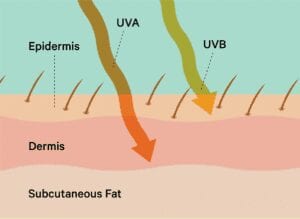SPF = Sun Protection Factor
SPF is a relative measure of how long a sunscreen should protect you from the sun. This amount of protection is different for everybody, based on your skin type and how quickly you burn. It is defined as the amount of UV light it takes to cause redness in the skin while wearing sunscreen, as compared to when you are unprotected (and not wearing sunscreen).
Example: Let’s say your skin turns red in 2 minutes while you are unprotected and out in the sun. This means an SPF of 30 should protect you 30 times longer than 2 minutes. Therefore, 2 x 30 = 60 minutes (1 hour) of protection. In the same scenario, a person who is unprotected and turns red in 10 minutes while unprotected and out in the sun, would obtain 300 minutes (5 hours) of protection from the same 30 SPF sunscreen.
There are 3 types of rays from the sun:
UVA: Less strong than UVB, travels deeper into the skin.
- The main cause of tanning, skin aging, and a small amount of sunburn.
UVB: Stronger than UVA, stays more superficial in the skin.
- The main cause of sunburn and plays a key role in the development of skin cancer.
UVC: Very strong. Our ozone layer currently blocks this.

Because Ultraviolet B (UVB) rays are the primary cause of sunburn, SPF measures mostly UVB protection. An SPF of 30 protects you from almost 97% of UVB. Therefore, anything above 30SPF will not offer a significant amount of greater protection, unless you plan to be in the sun for a very extended period of time. A minimum of 30SPF is a great place to start to ensure protection of your body’s largest organ. Also, because UVA can contribute to a small amount of sunburn, it is best to choose a broad spectrum sunscreen that protects from both UVA and UVB rays.
